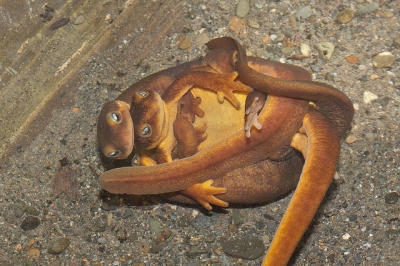How I Spent My Summer: Streaming in Santa Monica Mountains
Most of my July was spent wading through our local Santa Monica Mountain streams, assessing the biological communities and habitat within them. Despite some of the less glamorous aspects, such as battling poison oak, stinging nettle, and the occasional tick, I relished in the opportunity to get out of the office and immerse myself, literally and figuratively, in the streams. I get to see secret spots in the Santa Monica Mountains that few folks know about and see critters that largely go unnoticed and unappreciated.
Thanks to Heal the Bay staff, interns, and volunteers, we surveyed eight streams this year. Our primary goal of this yearly survey is to assess the biological community living in the stream. When I say “biological community,” many people think of fish, birds, and amphibians –-and these are all biological communities that use and depend on the streams – but I mean the bugs. These aquatic bugs are also called benthic macroinvertebrates: organisms with no backbone that live on the bottom (benthos) of the stream and are big enough to be seen with the naked eye. They include things like snails, worms, crayfish, and insects.
Many of the insects found are the larval stages of dragonflies, damselflies, black flies, and mayflies. The type and quantity of bugs that you can find in a stream tell you a lot about the quality of the water and the habitat. Depending on the community of bugs that we find, we can give our streams a rating on their biological health. We currently use a scoring system called the Index of Biotic Integrity or IBI score. The score can range from 0 to 100, with scores of 0-20 indicating very poor conditions, 21-40 indicating poor conditions, 41-60 indicating fair, 61-80 indicating good, and 81-100 indicating excellent conditions.
The streams that we assess show a wide range of scores – the best being Upper Cold Creek with an average score of 77 and the worst being Triunfo Creek at Kanan Road with an average score of 13. Bugs can be thought of as an indicator species (or more appropriately, “indicator group”), which means that they are a sensitive group and their presence can be used to indicate information about the health of the stream. Indicator species can also be used as an early warning system; if they show a decline or problems, there is likely to be a greater danger to the ecosystem or other species.
Besides bugs, another group that is typically thought of as an indicator group are amphibians. They are very sensitive to pollution and habitat degradation and sometimes the first organisms to show evidence of a problem – along with bugs, they are considered the “canary in the coalmine” for the aquatic world. This year during our biological assessments of the streams, we saw many native amphibians, including the Pacific tree frog (Pseudacris regilla), California tree frog (Pseudacris cadaverina), California toad (Bufo boreas), and the California newt (Taricha torosa). We saw lots of metamorphs, which are frogs that have just metamorphosed from tadpoles and they are very small and extremely cute. Since I described some of the cool bugs that we find in the streams last year, I thought I’d describe some of our local amphibians.
- The most common native frog in the Santa Monica Mountains is the Pacific tree frog; it is distinguishable from other frogs by a dark stripe that runs through the middle of each eye. These frogs are variable in color and typically are green or brown, and always with an eye strip.
- Their sister species, the California tree frog is less common and tends to be found in rocky streams where they blend in to gray rocks. These frogs are more warty and gray or washed out in color (like a cadaver, hence their name P. cadaverina) with no eye stripe. Their call sounds like a duck quacking whereas the Pacific tree frog sounds more cricket-like.
 The California newt is another cool amphibian – they are dark orange/brown on top and bright yellow/orange underneath. That bright coloration is to warn you that they are highly toxic! Newts contain a potent neurotoxin, called tetrodotoxin, which repels predators. Newts live on the land most of the year then become aquatic during the breeding season. Male CA newts fight over access to females and if you’re lucky, you might see a newt mating ball in the spring.
The California newt is another cool amphibian – they are dark orange/brown on top and bright yellow/orange underneath. That bright coloration is to warn you that they are highly toxic! Newts contain a potent neurotoxin, called tetrodotoxin, which repels predators. Newts live on the land most of the year then become aquatic during the breeding season. Male CA newts fight over access to females and if you’re lucky, you might see a newt mating ball in the spring. - California red-legged frogs used to be common in southern California but now are found in only one spot in the Santa Monica Mountains and are listed as threatened by the U.S. Fish and Wildlife Service. We were not lucky enough to see them but had to take extra care and caution when we visited a stream where they have been documented. The National Park Service is planning to reintroduce the frogs to other locations in the mountains.
Unfortunately, many of these cool native amphibians are declining due to loss of habitat and invasive, non-native species that prey on eggs and larvae of amphibians, such as bullfrogs, crayfish, and introduced fish.
— Katherine Pease,
Heal the Bay Watershed Scientist
You can help amphibians by never releasing unwanted pets or animals, removing invasive crayfish from Malibu Creek with Mountains Restoration Trust, and protecting their habitat through our monthly restoration events.
Find out more about Heal the Bay’s Stream Team.


